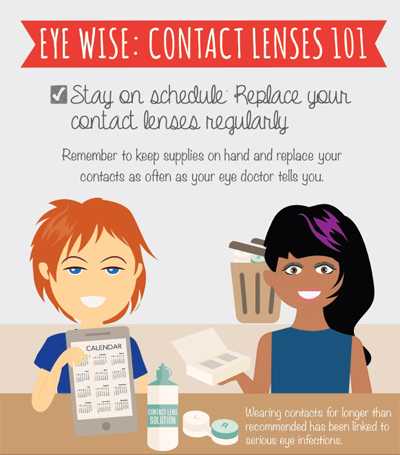Improper care of contact lenses can cause serious eye infections
Contact lens wearers can take simple steps to prevent infections and damage
This website is archived for historical purposes and is no longer being maintained or updated.
Press Release
Embargoed Until: Thursday, August 18, 2016, 1:00 p.m. ET
Contact:

Eye Wise: Contact Lenses 101
Entire infographic
Nearly 1 in 5 contact lens-related eye infections reported to a federal database involved a patient who experienced eye damage, according to a report published in CDC’s Morbidity and Mortality Weekly Report (MMWR).
The infections, submitted to the U.S. Food and Drug Administration’s (FDA) Medical Device Report Database, included patients who had a scarred cornea, needed a corneal transplant, or otherwise suffered a reduction in vision. These contact lens-related eye infections can lead to long-lasting eye damage but are often preventable.
“Contact lenses are a safe and effective form of vision correction when worn and cared for as recommended,” said Michael Beach, Ph.D., director of CDC’s Healthy Water Program. “However, improper wear and care of contact lenses can cause eye infections that sometimes lead to serious, long-term damage.”
Contact lens manufacturers, eye care providers, and patients can report adverse events related to contact lens use to the FDA, which regulates contact lenses as medical devices. The report reviewed 1,075 contact lens-related infections reported to FDA between 2005 and 2015.
More than 10 percent of the reports indicated that the patient went to an emergency department or urgent care clinic for immediate care. Whether eye infections are minor or lead to long-lasting damage, they can be painful and disrupt daily life. For instance, the reports describe patients’ daily visits to an eye doctor or hourly administration of eye drops to treat the infection.
The MMWR was released in advance of Contact Lens Health Week, which runs August 22-26 and promotes healthy wear and care practices that can help contact lens wearers reduce their chances of getting an eye infection. Contact lens wearers can help prevent infections by properly using lenses and supplies and following directions on the lens labels. More than 1 out of 4 reports of infections mentioned easily avoidable behaviors that increase the chance of getting an eye infection, such as wearing contact lenses while sleeping and wearing them longer than recommended.
“Around 41 million people in the United States wear contact lenses and benefit from the improved vision and comfort they provide,” said Jennifer Cope, M.D., M.P.H., medical epidemiologist in CDC’s Waterborne Disease Prevention Branch. “While people who get serious eye infections represent a small percentage of those who wear contacts, they serve as a reminder for all contact lens wearers to take simple steps to prevent infections.”
The findings in this report highlight the need for contact lens wearers to take good care of their lenses to help prevent contact lens-related eye infections.
Three recommendations related to commonly reported and risky behaviors:
- Don’t sleep in contact lenses without discussing with your eye doctor. Sleeping in contact lenses increases the chance of an eye infection by 6 to 8 times.
- Don’t top off, or add new contact lens solution to old solution that has been sitting in the case. Adding new solution to used solution can lower germ-killing power.
- Replace your contact lenses as often as recommended by your eye doctor. People who do not replace their lenses as often as recommended have more complications and report more eye problems than those who follow the replacement recommendations.
- Page last reviewed: August 18, 2016 (archived document)
- Content source:



 ShareCompartir
ShareCompartir